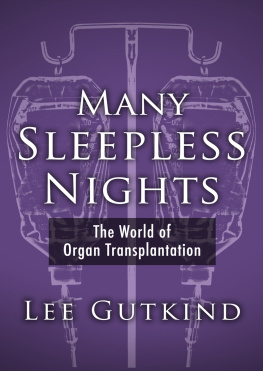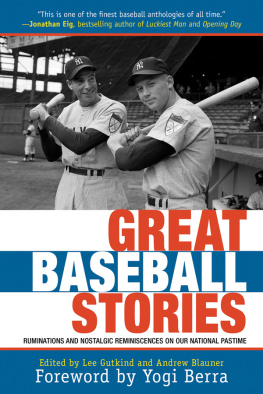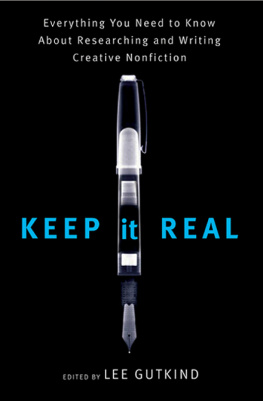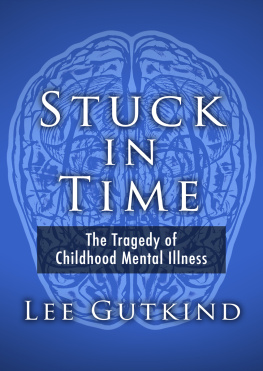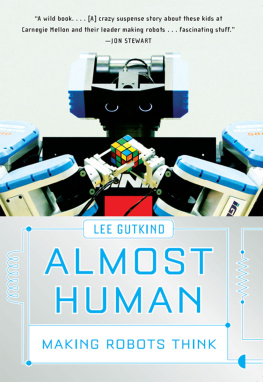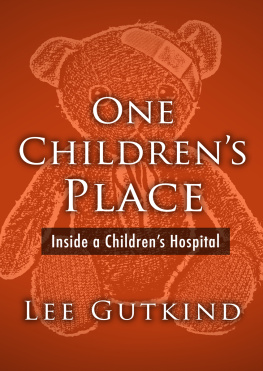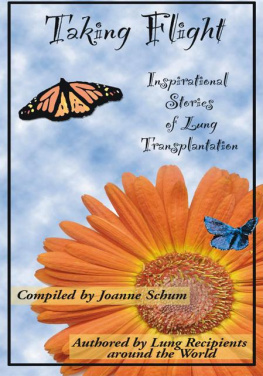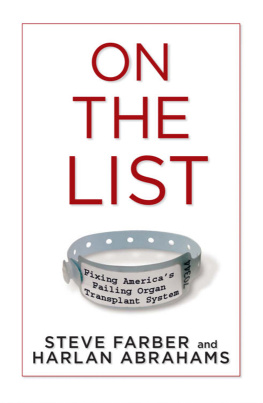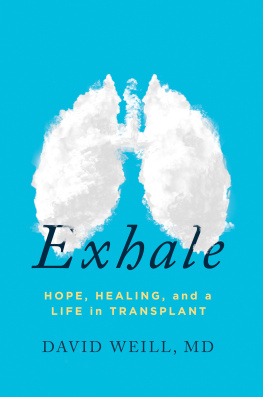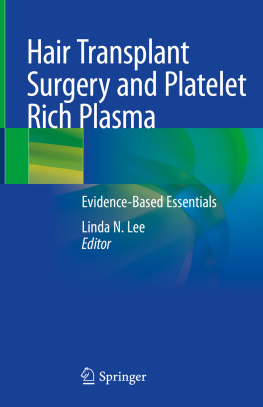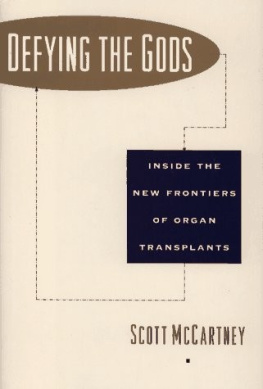Many Sleepless Nights
The World of Organ Transplantation
Lee Gutkind

To those patients who lived, and to those who died fighting; to their families, who suffered with them and the families of their donors, who suffered differently, but equally.
And to those members of organ transplant teams around the worldsurgeons, nurses, coordinators, social workers, procurement specialistswithout whom so many sick and dying people would have been forever denied their fighting chance.
No pseudonyms have been used in this book, no composite characters. Everyone who appears in this book is real. They have contributed their stories generously.
A scientific discovery is never the work of a single person. Each of those who collaborated in it has contributed many sleepless nights.
LOUIS PASTEUR,
French chemist and bacteriologist
Introduction
DESPITE ITS GENERALLY CONSCIENTIOUS coverage, the media has presented society with a rather skewed portrait of the world of organ transplantation.
Watching TV news and scanning headlines, viewers and readers often glimpse transplant surgeons at press briefings announcing successful and innovative procedures. But years of laboratory experimentation, hundreds of practice operations on animal subjects and many failures have preceded that moment in the limelight. In fact, surgery is the easier part of the battle, while the danger to the patient after surgerythe immune systems natural tendency to reject the implanted organhas been a much more difficult and challenging area to conquer. Over the past thirty-five years, two generations of surgeons and scientists have attempted to unravel the secret of immunosuppression, with as yet limited success.
Transplant surgeons have periodically tested and expanded societys moral and ethical boundariesand paid heavily in the process. In 1984, when doctors transplanted the heart of a baboon into a dying infant, Baby Fae, the surgeon, Dr. Leonard Bailey, was soundly criticized by many, including colleagues. One surgeon observed that the childs chances of survival would have been equally served if Bailey had dispensed with the baboonand sewn in an alarm clock.
Such cynicism must be put into perspective. Baby Fae lived twenty days, and surgeons learned a great deal about the feasibility of xenografting (transplantation from one species to another)a notion that may well become more palatable if the organ donor shortage is not somehow eased: more than 40 percent of infants and young children on transplant lists will die in 1988 while awaiting a suitable organ match. Baileys work might be compared with the experimentation of another young surgeon two decades earlier, Dr. Thomas Starzl, who was criticized with equal harshness for repeatedly transplanting human livers from brain-dead donors into adults and children who died within days, weeks, or months.
Today, liver (and heart and kidney) transplantation are well-accepted therapy, covered by private insurance companies, Blue Cross and Blue Shield organizations, Medicaid, and (in some instances) Medicare programs. Coverage is just one indication of how far transplantation has traveled. State and federal laws have been passed prohibiting the sale of donor organs. A transplant bureaucracy has been created and funded by the federal government, requiring hospitals to offer the option of donation to families and potential donors. The U.S. Department of Health and Human Services will deny Medicare or Medicaid reimbursement to institutions that do not comply.
In addition to the surgeons and researchers, nurses, social workers, and procurement coordinators have contributed generously to early pioneering efforts. But it is the patientsrecipients of heart, kidney, and liver transplantswho should be singled out for their courage. It might not be completely accurate to call patients heroes, but the earliest ones in particular were willing to endure tremendous pain and suffering essentially for the sake of those in similar circumstances who might someday follow in their footsteps. This willingness to contribute continues today, not only for the heart-lung and pancreas recipientstransplants that are still considered experimentalbut also for the even more complex attempts at lifesaving, such as xenografting and multiple organ (pancreas, liver, spleen, and intestines) procedures.
Perhaps the most frequent misconception concerning the transplant experience as it is today is the assumption that once the procedure is successfully completed, the patient can return to a normal life. This is often not true. Rejection of the transplanted organs is a never-ending threat, only partially controlled by great quantities of medications, which recipients must take for the remainder of their lives. Even if rejection remains in check, the side effects from the medications are often so severe that a return to normalcy is virtually impossible. The three major immunosuppressants currently usedcyclosporine, azathioprine (Imuran), and steroidshave caused, among many other problems, kidney failure, lymphoma, osteoporosis, cataracts, gout, hypertension, and severe mood swings. Because a recipients immune system is severely weakened by the immunosuppressive drugs, such minor infections as the common cold can become threatening. Medications will cost the transplant recipient anywhere from $7,000 to $10,000 annually. The onus of having been transplanted, combined with the physical limitations caused by the drugs, often makes it difficult for recipients to find employment. These emotional and financial hardships have destroyed many families. Ironically, the disease that originally triggered the transplant can also returnor the implanted organ can one day failnecessitating retransplantation.
Yet the value and importance of transplantation is certain. In the four years in which I have been intimately involved in the transplant world, primarily in Pittsburgh, but also at many of the other major transplant institutions in the United States and England, I became convinced that this view predominates. Thousands of patients, dying from incurable liver, heart, and lung disease, have been returned to productive lives because of organ transplantation. Children have been given the opportunity to experience adolescence and beyond. Families have been torn apart by the hardship of transplantation, but many also have been further united by the experience.
Today, forty-three-year-old Brian Reames of Greenville, Pennsylvania, a former army career officer, who was essentially confined to his bedroom for the three years prior to his 1982 heart transplant, has helped raise his three children, while establishing TRIO, Transplant Recipients International Organization, and attending graduate school to retrain himself. Winifred (Winkle) Fulk of Kansas City, Missouri, also forty-three, with four children, is now working on a second masters degree while teaching part time at a community college. In 1985, Winkle required an oxygen bottle to breathe and a wheelchair to move about the house. Doctors gave her weeks, a couple of months at most, to liveunless she received a heart-lung transplanther one and only remaining option for survival.
Brian, Winkle, and the many other recipients whose stories are told in this book, realize as do the surgeons, such as Thomas Starzl of the University of Pittsburgh and Denton Cooley of the Texas Heart Institute, that organ transplantation is not an ultimate answer. But despite the difficulties, most recipients are wholeheartedly appreciative. Transplantation has provided them with the opportunity to contribute to society, to watch their children grow, and to experience the many simple joys and gifts that life provides.

